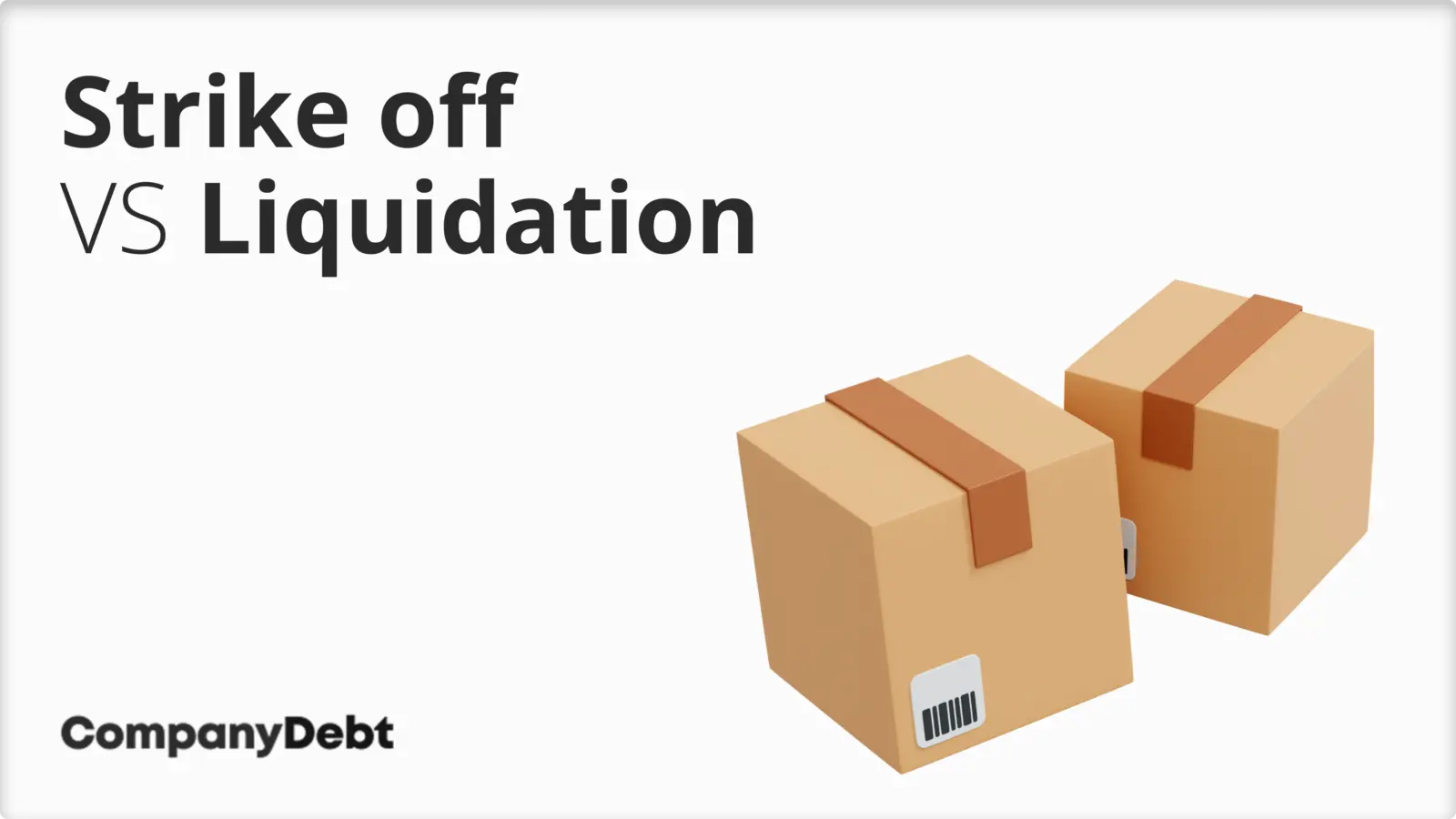
Striking off a Company vs. Members’ Voluntary Liquidation
When the time comes to close down a solvent company, directors and shareholders have two main options: striking off or Members’ Voluntary Liquidation (MVL).
While both methods ultimately result in the company being removed from the Companies House register, they have distinct differences that can significantly impact the process, costs, and tax outcomes for the company and its stakeholders.
I’ll explain how these differ below.

When to Consider Striking Off or MVL
As a general rule, MVLs can offer tax benefits for companies with assets over £25k. If you’re a smaller company, striking off is the easier and more cost-effective option [1]Trusted Source – GOV.UK – Members’ voluntary liquidation.
This table clearly explains the benefits and drawbacks of each choice.
| Striking Off | Members’ Voluntary Liquidation (MVL) | |
|---|---|---|
| Suitable for | Companies with no assets or liabilities | Companies with significant assets (£25k+) |
| Cost | Minimal (only filing fee) | Higher (professional fees involved) |
| Timeline | 2-3 months | 6-12 months |
| Formality | Simple, can be done online | Formal process, requires liquidator |
| Tax benefits | None | Business Asset Disposal Relief reduces the Capital Gains Tax rate to 10% |
| Public record | Yes | Yes |
| Risk of objections | Yes | No |
| Risk of restoration | Yes | No |
Striking off is the Right Option if:
- Your company has ceased trading and has no assets or liabilities.
- You have no plans to distribute any remaining funds to shareholders.
- You want a simple, low-cost way to remove the company from the Companies House register.
Examples for striking off:
- A small consultancy firm with no physical assets decides to close down due to its owner’s retirement. The company has no outstanding debts or liabilities, making it a suitable candidate for striking off.
- A startup that never gained traction and has been dormant for over a year opts to strike off to minimise ongoing compliance costs. The company has no assets or creditors, so striking off is the simplest way to close down.
On the other hand, MVL might be more appropriate if:
- Your company has significant assets that need to be distributed to shareholders (£25k+).
- You want to take advantage of tax benefits, such as Business Asset Disposal Relief (formerly Entrepreneurs’ Relief). Gains qualifying for BADR are taxed at a flat rate of 10%, with a lifetime limit of £1 million. For higher-rate taxpayers, this effectively halves the amount you’re likely to pay as Capital Gains.
Examples for MVL:
- A successful family-owned business with significant cash reserves and property assets decides to close down due to the owners’ retirement. An MVL allows the shareholders to distribute the assets tax-efficiently and ensures all creditors are paid in full.
- A tech company that has developed valuable intellectual property is acquired by a larger firm. The shareholders use an MVL to wind down the original company, distributing the proceeds of the sale and benefiting from Business Asset Disposal Relief.
Ultimately, the decision depends on your company’s financial situation and the goals of its directors and shareholders.
Striking Off: Pros and Cons
Pros:
- Simplicity: The striking off process is straightforward and can be completed online
- Low cost: There are no professional fees involved, only a small filing fee payable to Companies House (£44 for a paper application and £33 for a digital application)
- Speed: The process usually takes around 2-3 months from start to finish
Cons:
- Limited to specific situations: Striking off is only suitable for companies with no assets or liabilities
- No formal distribution of funds: Any remaining assets must be distributed before applying for striking off
- Potential for objections: Creditors or other interested parties can object to the striking off, which can delay or prevent the process
- Risk of restoration: In some cases, a struck-off company can be restored to the register, which may result in liabilities for directors or shareholders
MVL: Pros and Cons
Pros:
- Formal and transparent: MVL is a well-defined legal process overseen by a licensed insolvency practitioner, providing transparency and protection for directors and shareholders
- Tax benefits: Distributions made through MVL may be subject to lower tax rates, such as Business Asset Disposal Relief (formerly Entrepreneurs’ Relief)
- Creditor protection: MVL ensures that all creditors are paid in full, reducing the risk of future liabilities for directors and shareholders
Cons:
- Higher costs: MVL involves professional fees for the insolvency practitioner, which can be higher than the cost of striking off
- Longer timeline: The MVL process typically takes longer than striking off, usually around 6-12 months
- More complex: MVL requires more paperwork and formalities, such as appointing a liquidator and holding shareholder meetings
- Public record: MVL is a matter of public record, which may not be desirable for some companies or shareholders
Choosing Between Striking Off and MVL: Understanding the £25,000 Threshold
The decision between striking off and Members’ Voluntary Liquidation (MVL) often hinges on the value of assets to be distributed to shareholders. A key threshold to consider is £25,000.
For companies with assets under £25,000:
- Striking off is usually the most cost-effective option.
- The process is simpler and less expensive than MVL.
- Shareholders can distribute assets informally before striking off.
For companies with assets over £25,000:
- MVL often becomes more tax-efficient, but this isn’t a hard rule.
- The tax benefits, particularly Business Asset Disposal Relief, can outweigh the higher costs of the MVL process.
- MVL allows for a more formal and protective distribution of assets.
How can we help?
At Company Debt, we offer independent, confidential and no-obligation advice for company directors who are looking to close their business.
We can help you identify the best route from a tax perspective and ensure you receive the protection you need. For more information, please contact our team today.
The primary sources for this article are listed below, including the relevant laws and Acts which provide their legal basis.
You can learn more about our standards for producing accurate, unbiased content in our editorial policy here.
- Trusted Source – GOV.UK – Members’ voluntary liquidation






